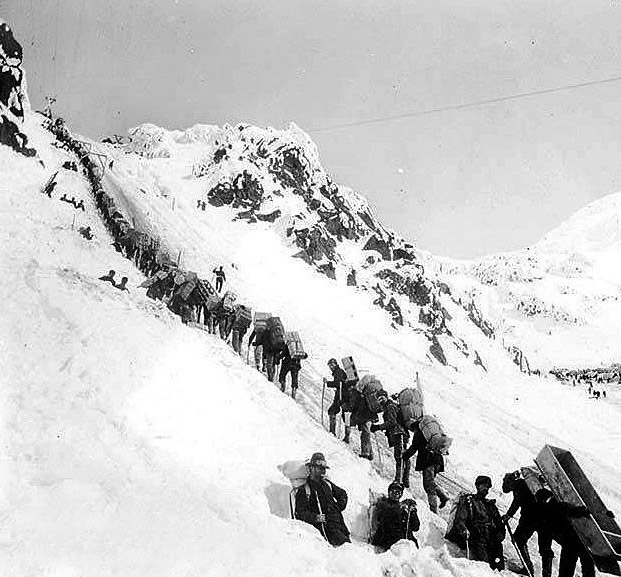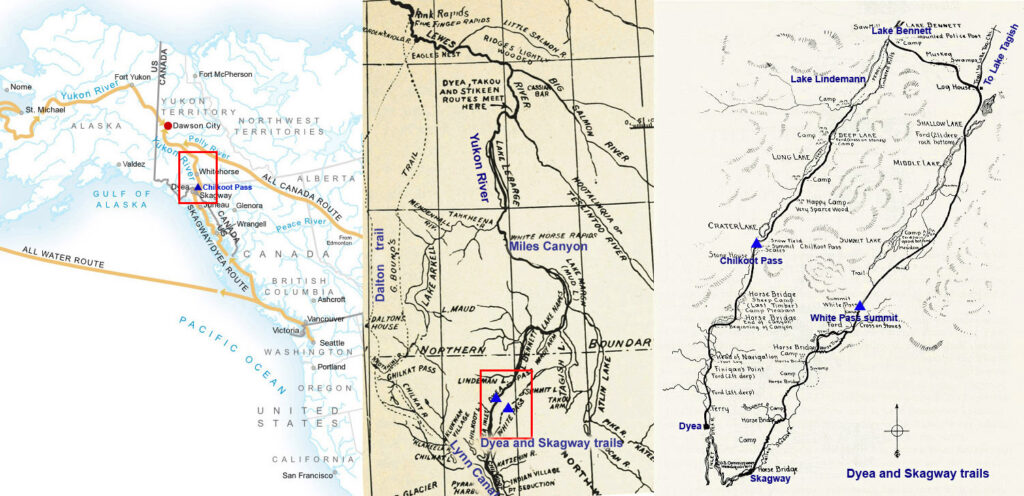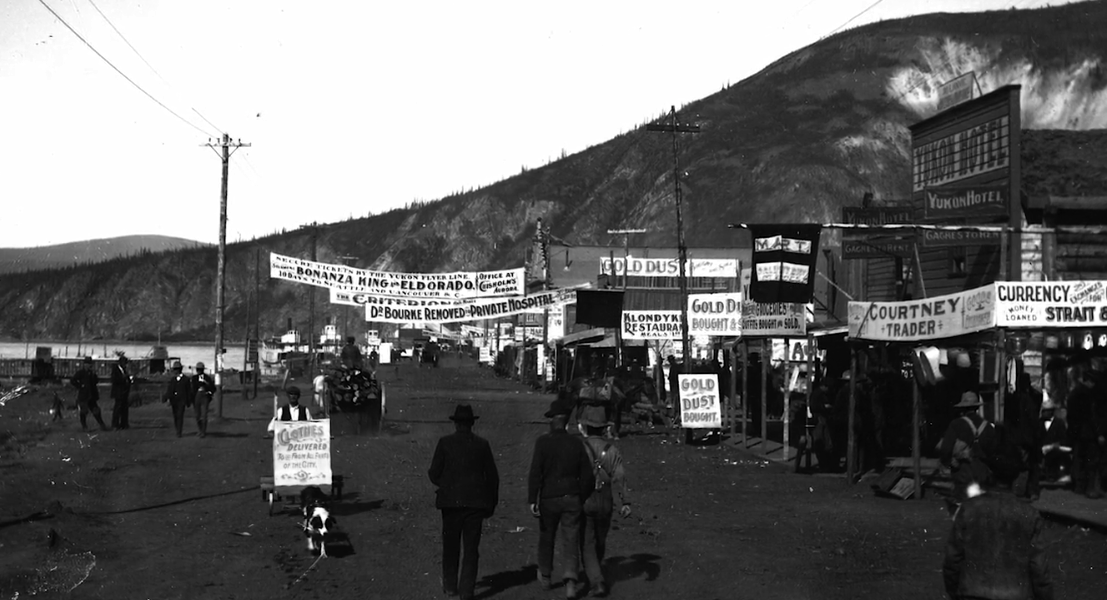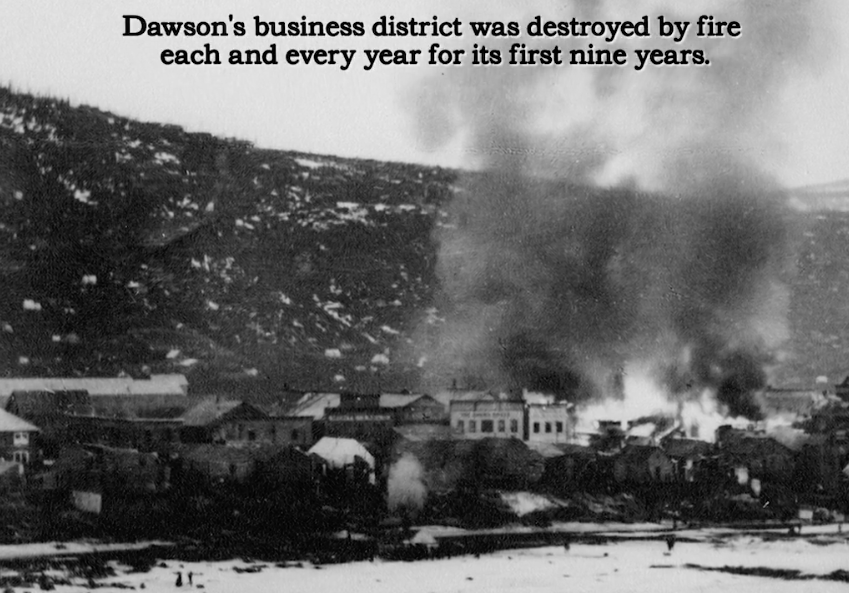Is this in the Pacific? Is there a voyage involved?
Sort of. Let me explain. In early 1896 Dawson was a sleepy Indian camp with a few gringo fur trappers. By 1896 the Indians had been tufted out and Dawson ballooned to a city of about 40,000. The growth of San Francisco was even more meteoric but it was situated on one of the world’s greatest seaports. To get to Dawson one walked 350 miles and then saw a sign that read: This is the end of the world! And there were still hundreds more miles to go.
During the Klondike Gold Rush upwards of 100,000 prospectors attempted the trip but only a third made it. The Canadian government required that each prospector bring 2,000 lbs. of supplies and at the top of the man-killing Chinook Pass the voyagers goods were weighed and allowed into Canada. Then they had to build boats and rafts and travel hundreds more miles to Dawson.

In Dawson they found astronomical prices and all sorts of manly entertainments in a swirl of gold dust and heartbreak. The residents built a fabulous recreation center with a swimming pool, ice rink and assembly hall; as well as hotels, saloons with gambling halls, brothels, restaurants, dressmakers and general stores.
Unlike the California Gold Rush this one cost more than it produced because only about 4,000 people found any gold. Jack London came and although he struck out as a prospector he did strike it rich with his Yukon stories like White Fang and To Build a Fire. By 1902 the population dropped to 5,000. Gold fever gees up a near religious fervor that is an alloy of greed and dreams. Gold fever strangles the gold miners’ heads and hearts and gold is held in such reverence that, strangely, there is no slang word for gold. As amazing as the Yukon Gold Rush is, this isn’t the important part of this story.
Even as Dawson became a backwater there were still folks interested in going to the movies, so in 1898 silent films came reeling into town. Since it was a question of going to the movies or watching the river freeze the locals saw the films over and over. In those days there were never enough prints for a simultaneous nationwide release in the lower 48 and Canada so it took a couple of years before the films made their way to this tiny population at the end of the world. Because of shipping costs, theater owners were told that once the films were exhibited to toss them out. At the time movie houses used an open carbon arc flame to generate sufficient light to project the film and since the cellulose/nitrate film stock is the same material that dynamite is made of many movie houses burned down.

“Grab the family Bible here we go again!”
So the movie folks followed procedure and gave the reels swimming lessons in the Yukon River or burned them as trash. This is one reason ¾ of the silent era films have been lost (one side note is that a young Sid Grauman, of theater fame, was in Dawson at this time).

“Sid, Sid…your hair, buddy!”
Then in the late 1970s an old building was being demolished and some movie film was spotted under the shovel of a bulldozer. They stopped the excavation and discovered that the abandoned swimming pool had been filled with crates of film. 533 reels in all. Many of these were the only copy. A lot were water damaged along the edges but most of 300 some films were salvaged.

A documentarian has created Dawson City: Frozen Time which is an exposition of the history of silent film woven with the meteoric rise and fall of Dawson City depicted with quick cuts. These include home movies of the Gold Rush, newsreels and dramatic films. The documentary weaves the story of the founding of Dawson with cuts from over a hundred of these films. This, combined with a surreal sound track makes watching it the closest thing I have ever had to a chemical free psychedelic experience. I expected that the whole thing might actually set my screen on fire and it was so powerful it took me three attempts to take it all in. You can find it on Netflix or YouTube.
So to watch this I suggest sitting down, strapping in and standing clear of open flames. You are in for a wild ride.

Easter Egg: Modern Love is a series from Amazon. How they shot this in pandemic times is hard to believe. But they did. The ten unrelated stories are about aspects of love, found, lost or thwarted in NYC. It features many big stars and more importantly is tightly written with original, believable and touching stories. It is one of the best things I have seen on the ol’ idiot box. Five stars or four if that as high as you go or three if you’re the Michelin Guide. Or maybe eight if it’s the Burj Al Arab Hotel, in Dubai…(or zero if you are looking for Washington DC statehood)






Interesting history. A little different than going to Buck’s for lunch looking for gold.
going to need some more time for this
a lot to die jest
As always thanx for these